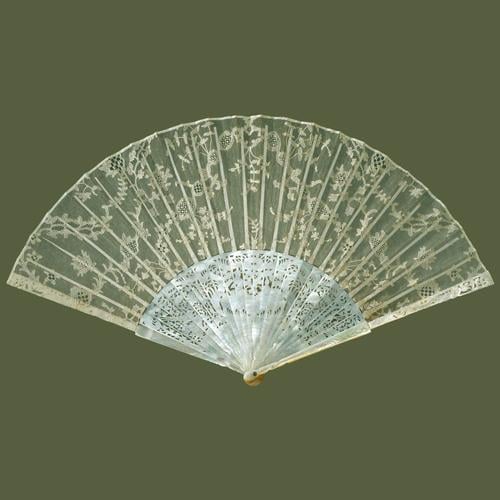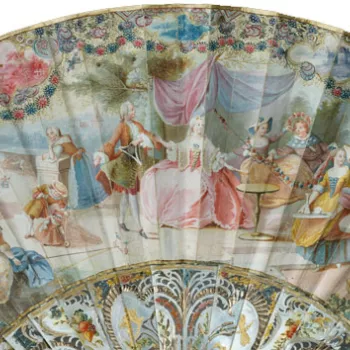Brussels lace fan c. 1780
Cream silk needle-lace leaf; carved, pierced and incised mother-of-pearl guards (matching) and sticks, painted bamboo ribs (2 + 22); silver pin with paste head | 28.0 cm (guardstick) | RCIN 25098
-
According to a note on the fan box, Queen Charlotte ‘had always used [this fan] at the Christenings of her children’. Although there would appear to be no means of substantiating this statement, the fact that the fan was once in the possession of her sixth son, Prince Augustus, Duke of Sussex, may support the claim. The fan appears to have been made a few years after the Prince’s own christening in 1773. Therefore it could not have been used at the christenings of the Queen’s older children, but could have been available for the christenings of Prince Octavius (born 1779) and Princess Amelia (born 1783). The fan is not identifiable in any of Queen Charlotte’s 1819 sale catalogues; it may therefore have been among the personal effects that were distributed among the Queen’s children immediately after her death. Prince Augustus was an executor of the estate of his elder sister, Princess Augusta, who died in 1840, and may have acted as the conduit for the family possessions (including fans) which passed from Princess Augusta to their niece, Queen Victoria.
The leaf is cut from a large piece of Brussels lace, rather than being made of a shaped piece of lace. The pattern pieces are of needle lace; they are grounded with fine bobbin-made drochel net, made up from a number of invisibly joined narrow strips. Although the pattern is not complete, the ratio of design to plain ground suggests a date in the late 1770s or 1780s.
Large sums of money were spent on fine Brussels lace for Queen Charlotte’s use. The Great Wardrobe Accounts record that in 1762, before the impending birth of her first child, a ‘Sitting up State Bed’ was supplied for the Queen’s use during her reception of important visitors after the birth. The suite of ‘Superfine Flanders point Lace to Cover all over’, charged at £2,699, cost considerably more than the woodwork and hangings of the bed. The supplier was ‘Priscilla MacEune Lacewoman’. In the same account, and from the same source, was a ‘suit of the Like Lace to Cover a Toilet Table Compleat’, costing £1,079 14s. It seems very likely that the lace mentioned in the latter account is that shown in Zoffany’s painting of the Queen and her two eldest sons of c.1765. A flounce of Brussels lace from Queen Charlotte’s collection was given by Queen Victoria to the future Queen Mary on her marriage in 1893. Queen Charlotte’s marriage fan was described by a contemporary as ‘ivory sticks, finely carved, the Mount Brussels lace, price forty guineas’.
This may be the fan held by Queen Victoria in Leslie’s painting of the Christening of the Princess Royal in 1841. In 1893 the fan was shown open in the Queen’s hand, both in a painting by Laurits Tuxen (The Marriage of George, Duke of York, and Princess Mary of Teck, 6 July 1893) and in a photographic portrait taken by W. & D. Downey at the time of the marriage of Princess Victoria Mary of Teck (later Queen Mary) to the Duke of York (the future King George V); the photograph was later used as an official portrait for the Queen’s Diamond Jubilee in 1897.
Text adapted from Unfolding Pictures: Fans in the Royal Collection 2005Provenance
Queen Charlotte; given by her son, Prince Augustus, Duke of Sussex, to his niece, Queen Victoria, in 1841
-
Creator(s)
(nationality)(nationality)Acquirer(s)
-
Medium and techniques
Cream silk needle-lace leaf; carved, pierced and incised mother-of-pearl guards (matching) and sticks, painted bamboo ribs (2 + 22); silver pin with paste head
Measurements
28.0 cm (guardstick)
Place of Production
Belgium









